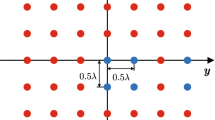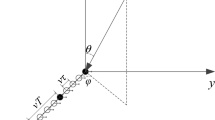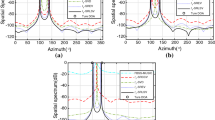Abstract
An acoustic vector sensor (AVS) can capture more information than a conventional acoustic pressure sensor (APS). As a result, more output channels are required when multiple AVS are formed into arrays, making processing the data stream computationally intense. This paper proposes a new algorithm based on the propagator method for wideband coherent sources that eliminates eigen-decomposition in order to reduce the computational burden. Data from simulations and lake trials showed that the new algorithm is valid: it resolves coherent sources, breaks left/right ambiguity, and allows inter element spacing to exceed a half-wavelength.
Similar content being viewed by others
References
D’SPAIN G L. Vector sensors and vector sensor line arrays: comments on optimal array gain and detection[J]. J Acoust Soc Am.2006, 120(1): 171–185.
D’SPAIN G L. Initial analysis of the data from the vertical DIFAR array[C]//Ocean’92: Mastering the Oceans Through Technology. Newport, Rhode Island, USA. 1992.
TICHAVSKY P, WONG K T. Near-field/far-field azimuth and elevation angle estimation using a single vector hydrophone[J]. IEEE Trans SP, 2001, 49(11): 2498–2510.
ZOLTOWSKI M D, WONG K T. Closed-form eigenstructure based direction finding using arbitrary but identical subarrays on a sparse uniform Cartesian array grid[J]. IEEE Trans SP, 2000, 48(8): 2205–2210.
MARCOS S. The propagator method for source bearing estimation[J]. Signal Processing, 1995, 42: 121–138.
WANG H, KAVEH M. Coherent signal-subspace processing for the detection and estimation of angles of arrival of multiple wide-band sources[J]. IEEE Trans ASSP, 1985, 33(4): 823–831.
CHEN H W, ZHAO J W. Wideband MVDR beamforming for acoustic vector sensor linear array[J]. IEEE Proc Radar Sonar Navig, 2004, 151(3): 158–162.
KROLIK J, SWINGLER D. The performance of minimax spatial resampling filters for focusing wide-band arrays[J]. IEEE Trans SP, 1991, 39(8): 1899–1903.
Author information
Authors and Affiliations
Corresponding author
Additional information
Foundation item: Supported by the National 863 Plan Project of Ministry of Science and Technology of China under Grant No.2006AA09Z234.
SUN Guo-cang was born in 1977. He is a PhD candidate for underwater acoustic engineering at the College of Underwater Acoustic Engineering, Harbin Engineering University. His research interests include underwater acoustic signal processing and structure vibration.
HUI Jun-ying was born in 1939. He is a professor and a doctor supervisor of underwater acoustic engineering at Harbin Engineering University. His research interests include underwater acoustic signal processing and underwater physics.
CHEN Yang was born in 1982. He is a PhD candidate for underwater acoustic engineering at the College of Underwater Acoustic Engineering, Harbin Engineering University. His research interest is focused on underwater acoustic signal processing.
Rights and permissions
About this article
Cite this article
Sun, Gc., Hui, Jy. & Chen, Y. Fast direction of arrival algorithm based on vector-sensor arrays using wideband sources. J. Marine. Sci. Appl. 7, 195–199 (2008). https://doi.org/10.1007/s11804-008-7079-8
Received:
Published:
Issue Date:
DOI: https://doi.org/10.1007/s11804-008-7079-8




